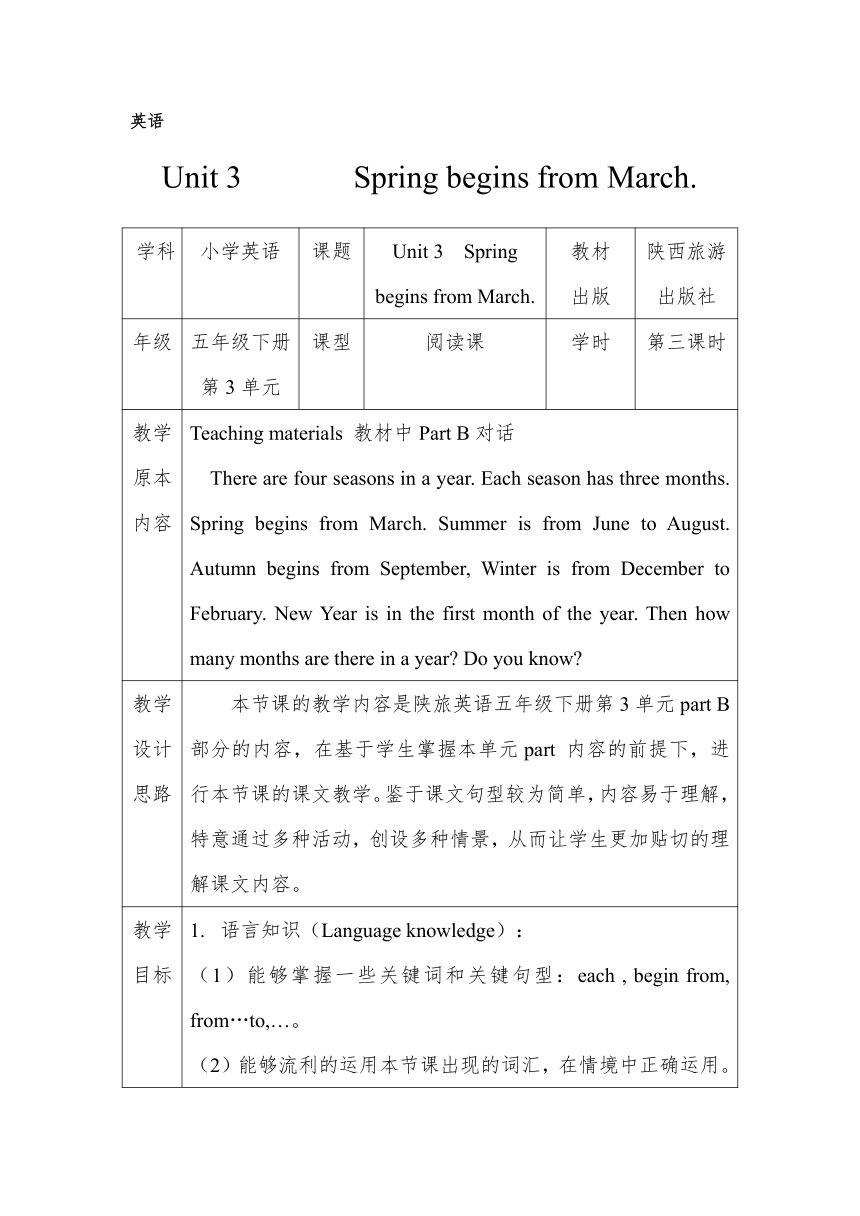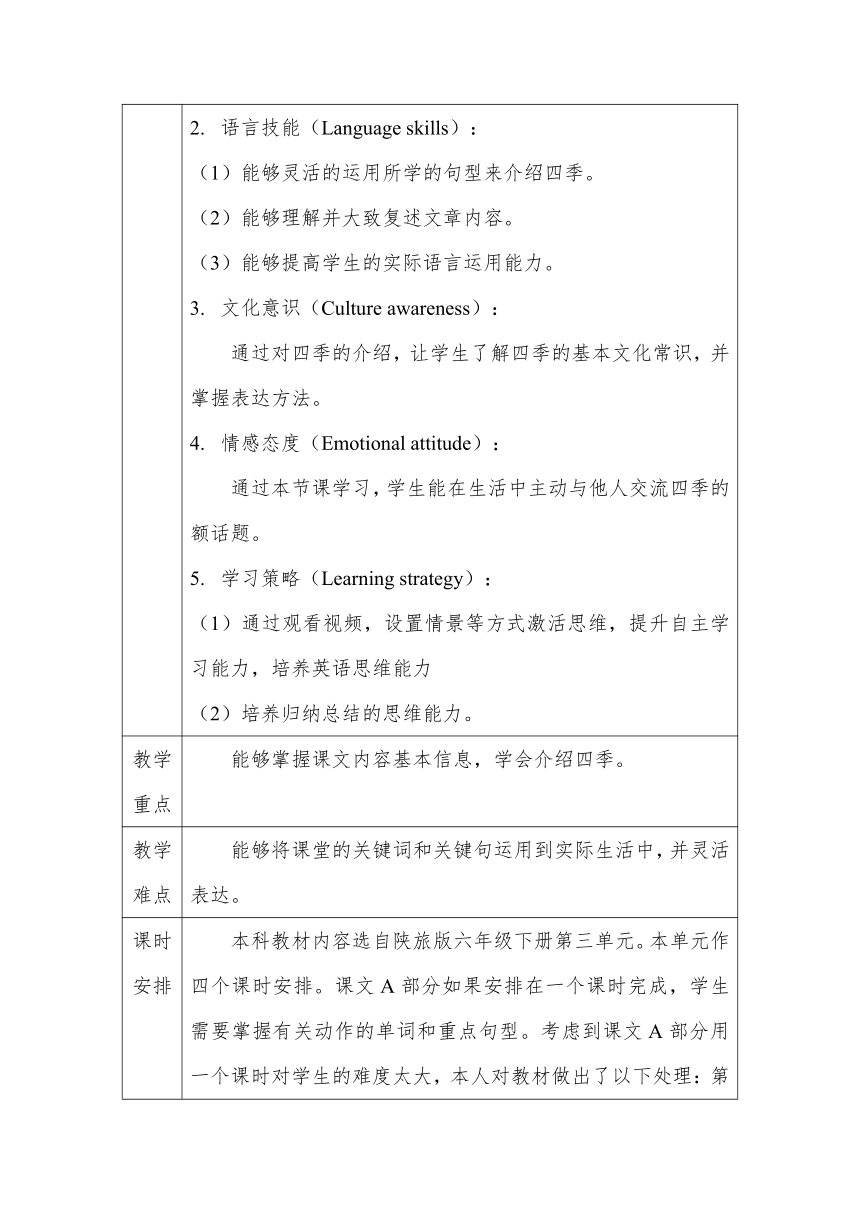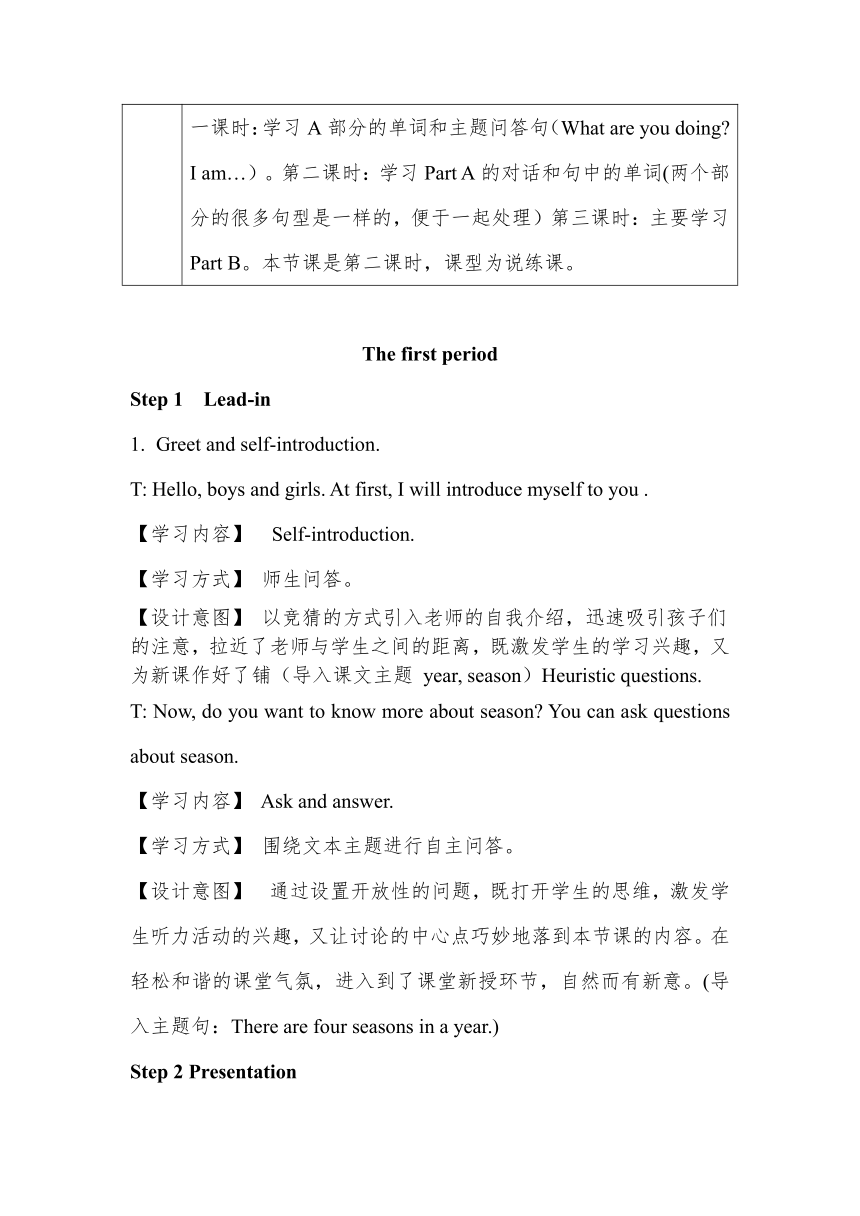Unit3 Spring Begins From March partB 教案
文档属性
| 名称 | Unit3 Spring Begins From March partB 教案 |  | |
| 格式 | doc | ||
| 文件大小 | 53.0KB | ||
| 资源类型 | 教案 | ||
| 版本资源 | 陕旅版 | ||
| 科目 | 英语 | ||
| 更新时间 | 2022-03-10 19:48:40 | ||
图片预览



文档简介
英语
Unit 3 Spring begins from March.
学科 小学英语 课题 Unit 3 Spring begins from March. 教材出版 陕西旅游出版社
年级 五年级下册第3单元 课型 阅读课 学时 第三课时
教学原本内容 Teaching materials 教材中Part B对话There are four seasons in a year. Each season has three months. Spring begins from March. Summer is from June to August. Autumn begins from September, Winter is from December to February. New Year is in the first month of the year. Then how many months are there in a year Do you know
教学设计思路 本节课的教学内容是陕旅英语五年级下册第3单元part B部分的内容,在基于学生掌握本单元part 内容的前提下,进行本节课的课文教学。鉴于课文句型较为简单,内容易于理解,特意通过多种活动,创设多种情景,从而让学生更加贴切的理解课文内容。
教学目标 1. 语言知识(Language knowledge):(1)能够掌握一些关键词和关键句型:each , begin from, from…to,…。(2)能够流利的运用本节课出现的词汇,在情境中正确运用。2. 语言技能(Language skills):(1)能够灵活的运用所学的句型来介绍四季。(2)能够理解并大致复述文章内容。(3)能够提高学生的实际语言运用能力。3. 文化意识(Culture awareness):通过对四季的介绍,让学生了解四季的基本文化常识,并掌握表达方法。4. 情感态度(Emotional attitude):通过本节课学习,学生能在生活中主动与他人交流四季的额话题。5. 学习策略(Learning strategy):(1)通过观看视频,设置情景等方式激活思维,提升自主学习能力,培养英语思维能力(2)培养归纳总结的思维能力。
教学重点 能够掌握课文内容基本信息,学会介绍四季。
教学难点 能够将课堂的关键词和关键句运用到实际生活中,并灵活表达。
课时安排 本科教材内容选自陕旅版六年级下册第三单元。本单元作四个课时安排。课文A部分如果安排在一个课时完成,学生需要掌握有关动作的单词和重点句型。考虑到课文A部分用一个课时对学生的难度太大,本人对教材做出了以下处理:第一课时:学习A部分的单词和主题问答句(What are you doing I am…)。第二课时:学习Part A的对话和句中的单词(两个部分的很多句型是一样的,便于一起处理)第三课时:主要学习Part B。本节课是第二课时,课型为说练课。
The first period
Step 1 Lead-in
1. Greet and self-introduction.
T: Hello, boys and girls. At first, I will introduce myself to you .
【学习内容】 Self-introduction.
【学习方式】 师生问答。
【设计意图】 以竞猜的方式引入老师的自我介绍,迅速吸引孩子们的注意,拉近了老师与学生之间的距离,既激发学生的学习兴趣,又为新课作好了铺(导入课文主题 year, season)Heuristic questions.
T: Now, do you want to know more about season You can ask questions about season.
【学习内容】 Ask and answer.
【学习方式】 围绕文本主题进行自主问答。
【设计意图】 通过设置开放性的问题,既打开学生的思维,激发学生听力活动的兴趣,又让讨论的中心点巧妙地落到本节课的内容。在轻松和谐的课堂气氛,进入到了课堂新授环节,自然而有新意。(导入主题句:There are four seasons in a year.)
Step 2 Presentation
1. Review the words of month.
T: Before we read the passage, let’s review the months.
【学习内容】 Review the key words.
【学习方式】 复习重点单词。
【设计意图】 本单元单词较难,通过复习的方式,将单词梳理,加深对单词的印象,又突破了单词的难点。
2. Skim the passage.
T: Read the passage quickly and put the months into correct blocks.
【学习内容】 Skim the passage and finish the exercises.
【学习方式】 匹配。
【设计意图】 通过略读,让学生在最短的时间了解文章大致的内容,从整体上迅速把握材料的的大致意思,通过紧抓关键词,突出本课的重点,并让学生了解阅读的方法,引领学生向更广、更深处进行阅读的提升。
2. Scan the passage.
T: Read the passage carefully and find the details.
(spring→ begins from March.
summer→ from June to August
autumn→ begins from September.
winter→ from December to February.
New Year→ in the first month of the year )
【学习内容】 Skim the passage and find the key words.
【学习方式】 自主寻找关键词。
【设计意图】 通过略读,让学生在最短的时间了解文章大致的内容,从整体上迅速把握材料的的大致意思,通过紧抓关键词,突出本课的重点,并让学生了解阅读的方法,引领学生向更广、更深处进行阅读的提升。
3. Text-mining.
T: According to these examples, make more sentences.
Spring begins from March.
Summer is from June to August.
New Year is in the first month of the year.
T: You can make sentences like this: Summer begins from June. …
【学习内容】Do the text-mining and make more sentences.
【学习方式】学生根据例子自主完成。
【设计意图】利用文本挖掘来操练重点句型,既让学生语言知识和技能得到提高,也对文本进行了有效的挖掘和深入。
Step 3 Practice
1. Watch the video and practice the passage in pairs.
T: Just now, you all did a very good job. Now I will give you two minutes to practice the passage. After that, you must read the passage loudly.
【学习内容】Practice the dialogues in pairs.
【学习方式】学生分角色练习课文原文。
【设计意图】利用图片和视频巧妙地呈现课文原文,既紧扣课文文本,又联系了上下文语境。
2 Watch the video again and retell the passage.
T: Let’s watch the video again. After that, you should close your books and retell the passage.
【学习内容】Retell the passage.
【学习方式】师生一起复述课文。
【设计意图】利用提醒关键词,巧妙地让学生复述课文原文,既紧扣课文文本,又利用了思维导图,促进了学生的英语思维。
Step 4 Extension.
T: Here is a table about the seasons in Australia(澳大利亚). Finish the passage according to the table.
【学习内容】Write a short passage.
【学习方式】自主完成并展示
【设计意图】利用制作对澳大利亚的介绍,训练了句型,又实现由说到写,由写到展示的蜕变,既检查了学生是否掌握本课知识,又让学生在灵活运用所学知识中得到语言能力的整体提高。
Step 5 Homework
1 Practice the passage with your partner.
2 Preview Unit 4.
【学习内容】Practice the passage.
【学习方式】自主学习
【设计意图】 培养学生说英语的能力,同时对学生进行情感教育。
主要特色与创新之处
创造性合理地使用教材。以学生为主体,有效设计学案。采用探究式合作学习方式,注重学习策略的掌握。注重学生学习兴趣的培养,避免过多的机械操练。情感目标无形渗透,达成自然。
PAGE
Unit 3 Spring begins from March.
学科 小学英语 课题 Unit 3 Spring begins from March. 教材出版 陕西旅游出版社
年级 五年级下册第3单元 课型 阅读课 学时 第三课时
教学原本内容 Teaching materials 教材中Part B对话There are four seasons in a year. Each season has three months. Spring begins from March. Summer is from June to August. Autumn begins from September, Winter is from December to February. New Year is in the first month of the year. Then how many months are there in a year Do you know
教学设计思路 本节课的教学内容是陕旅英语五年级下册第3单元part B部分的内容,在基于学生掌握本单元part 内容的前提下,进行本节课的课文教学。鉴于课文句型较为简单,内容易于理解,特意通过多种活动,创设多种情景,从而让学生更加贴切的理解课文内容。
教学目标 1. 语言知识(Language knowledge):(1)能够掌握一些关键词和关键句型:each , begin from, from…to,…。(2)能够流利的运用本节课出现的词汇,在情境中正确运用。2. 语言技能(Language skills):(1)能够灵活的运用所学的句型来介绍四季。(2)能够理解并大致复述文章内容。(3)能够提高学生的实际语言运用能力。3. 文化意识(Culture awareness):通过对四季的介绍,让学生了解四季的基本文化常识,并掌握表达方法。4. 情感态度(Emotional attitude):通过本节课学习,学生能在生活中主动与他人交流四季的额话题。5. 学习策略(Learning strategy):(1)通过观看视频,设置情景等方式激活思维,提升自主学习能力,培养英语思维能力(2)培养归纳总结的思维能力。
教学重点 能够掌握课文内容基本信息,学会介绍四季。
教学难点 能够将课堂的关键词和关键句运用到实际生活中,并灵活表达。
课时安排 本科教材内容选自陕旅版六年级下册第三单元。本单元作四个课时安排。课文A部分如果安排在一个课时完成,学生需要掌握有关动作的单词和重点句型。考虑到课文A部分用一个课时对学生的难度太大,本人对教材做出了以下处理:第一课时:学习A部分的单词和主题问答句(What are you doing I am…)。第二课时:学习Part A的对话和句中的单词(两个部分的很多句型是一样的,便于一起处理)第三课时:主要学习Part B。本节课是第二课时,课型为说练课。
The first period
Step 1 Lead-in
1. Greet and self-introduction.
T: Hello, boys and girls. At first, I will introduce myself to you .
【学习内容】 Self-introduction.
【学习方式】 师生问答。
【设计意图】 以竞猜的方式引入老师的自我介绍,迅速吸引孩子们的注意,拉近了老师与学生之间的距离,既激发学生的学习兴趣,又为新课作好了铺(导入课文主题 year, season)Heuristic questions.
T: Now, do you want to know more about season You can ask questions about season.
【学习内容】 Ask and answer.
【学习方式】 围绕文本主题进行自主问答。
【设计意图】 通过设置开放性的问题,既打开学生的思维,激发学生听力活动的兴趣,又让讨论的中心点巧妙地落到本节课的内容。在轻松和谐的课堂气氛,进入到了课堂新授环节,自然而有新意。(导入主题句:There are four seasons in a year.)
Step 2 Presentation
1. Review the words of month.
T: Before we read the passage, let’s review the months.
【学习内容】 Review the key words.
【学习方式】 复习重点单词。
【设计意图】 本单元单词较难,通过复习的方式,将单词梳理,加深对单词的印象,又突破了单词的难点。
2. Skim the passage.
T: Read the passage quickly and put the months into correct blocks.
【学习内容】 Skim the passage and finish the exercises.
【学习方式】 匹配。
【设计意图】 通过略读,让学生在最短的时间了解文章大致的内容,从整体上迅速把握材料的的大致意思,通过紧抓关键词,突出本课的重点,并让学生了解阅读的方法,引领学生向更广、更深处进行阅读的提升。
2. Scan the passage.
T: Read the passage carefully and find the details.
(spring→ begins from March.
summer→ from June to August
autumn→ begins from September.
winter→ from December to February.
New Year→ in the first month of the year )
【学习内容】 Skim the passage and find the key words.
【学习方式】 自主寻找关键词。
【设计意图】 通过略读,让学生在最短的时间了解文章大致的内容,从整体上迅速把握材料的的大致意思,通过紧抓关键词,突出本课的重点,并让学生了解阅读的方法,引领学生向更广、更深处进行阅读的提升。
3. Text-mining.
T: According to these examples, make more sentences.
Spring begins from March.
Summer is from June to August.
New Year is in the first month of the year.
T: You can make sentences like this: Summer begins from June. …
【学习内容】Do the text-mining and make more sentences.
【学习方式】学生根据例子自主完成。
【设计意图】利用文本挖掘来操练重点句型,既让学生语言知识和技能得到提高,也对文本进行了有效的挖掘和深入。
Step 3 Practice
1. Watch the video and practice the passage in pairs.
T: Just now, you all did a very good job. Now I will give you two minutes to practice the passage. After that, you must read the passage loudly.
【学习内容】Practice the dialogues in pairs.
【学习方式】学生分角色练习课文原文。
【设计意图】利用图片和视频巧妙地呈现课文原文,既紧扣课文文本,又联系了上下文语境。
2 Watch the video again and retell the passage.
T: Let’s watch the video again. After that, you should close your books and retell the passage.
【学习内容】Retell the passage.
【学习方式】师生一起复述课文。
【设计意图】利用提醒关键词,巧妙地让学生复述课文原文,既紧扣课文文本,又利用了思维导图,促进了学生的英语思维。
Step 4 Extension.
T: Here is a table about the seasons in Australia(澳大利亚). Finish the passage according to the table.
【学习内容】Write a short passage.
【学习方式】自主完成并展示
【设计意图】利用制作对澳大利亚的介绍,训练了句型,又实现由说到写,由写到展示的蜕变,既检查了学生是否掌握本课知识,又让学生在灵活运用所学知识中得到语言能力的整体提高。
Step 5 Homework
1 Practice the passage with your partner.
2 Preview Unit 4.
【学习内容】Practice the passage.
【学习方式】自主学习
【设计意图】 培养学生说英语的能力,同时对学生进行情感教育。
主要特色与创新之处
创造性合理地使用教材。以学生为主体,有效设计学案。采用探究式合作学习方式,注重学习策略的掌握。注重学生学习兴趣的培养,避免过多的机械操练。情感目标无形渗透,达成自然。
PAGE
